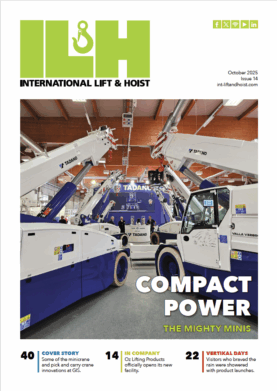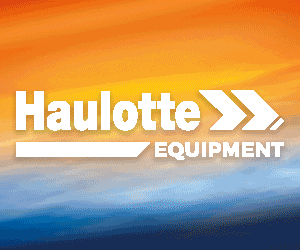)
Train Like a Champion
Training, especially on heavy-duty brakes and components, is now more important than ever, says Joel Cox, president at Pintsch Bubenzer USA.
I know that Ross Moloney, CEO, Lifting Equipment Engineers Association (LEEA), based a column in this magazine recently on a quote from a heavyweight boxer, but I want to share another one that’s also relevant as we start to emerge, eventually, from the grips of the pandemic.
Where Moloney quoted Mike Tyson, who suggested that, “Everyone has a plan until they get punched in the mouth,” I want to remind you of a comment by legendary pugilist Muhammad Ali, who said, “I hated every minute of training, but I said, ‘Don’t quit. Suffer now and live the rest of your life as a champion.’”
Actually, I don’t think we should look at training so negatively, but I know what Ali meant. Champions train hard, after all, and a robust training programme is integral to a championship mindset – in the gym, in life and in business. This was proven to me recently as I reflected on a series of training sessions that we have completed in Central America, the US and the Caribbean, covering installations and commissioning on equipment in the mining, steel, nuclear, ports and aerospace industries.
So vast is this geography, and so varied the end-user markets, the more alarming my realisation is: that we are walking into a pandemic of a different kind. Truth is, Covid and the enduring shortage of maintenance professionals have combined to create a scenario where training and monitoring, of brakes and other ancillary equipment, is going to be needed over the coming years more than ever.
Inescapably, the pandemic has lowered the headcount onsite and corners have been cut in certain instances regarding training. In industries where funding has been stretched, maintenance and repair has been overlooked too.
It’s prudent, therefore, to look at the role of manufacturers in training and urge everyone to revisit their programmes. The biggest mistake we can make is letting our guard down as the virus blows over. The pandemic might not be the “punch in the mouth”- the aftermath is. And if we don’t train for it, all our plans will unravel.
A manufacturer’s responsibility
The overhead crane and hoist market has its complexities. Product is made all over the world and there are manufacturers, builders, contractors, dealers, trainers, and so on. Manufacturers have got to play an integral role in training and lead education about their products. Equipment is getting higher tech, faster, heavier in capacity and smarter in design. Its makers understand more about their kit than anyone else because they’ve researched it, developed it, broke it, sold it, and installed it. They often improve it over time too.
To refer back to my wheelhouse – brakes – I believe they are the most overlooked product in terms of knowledge, training, maintenance and planning. That’s a big revelation given their importance to heavy-duty applications where millions of dollars can ride, literally, on every pick. But I think other component and ancillary equipment suppliers must feel the same. And Covid is only going to widen the knowledge gap.
The shift we have seen to frequency drives has helped lower the overall wear and tear on brakes, and other components have improved equally, but not all locations have the same protocols or safeties in place for power loss, emergency stops and dynamic braking conditions. The misconception in the industry now is, ‘These are just holding brakes. They’re static, not dynamic”. Reality is, they are so much more than that and the safety factors should always be considered within maintenance. The only way industry can understand that is to be properly and thoroughly trained, even if it might not be the easiest process to commit to, as Ali will testify.
Ali’s trainer, Angelo Dundee, would have known about his fighter’s dislike for training and would no doubt have tried to build enjoyment and variety into his programmes. Results are important as well – and Ali delivered those by the container load. Industry can take a leaf and make sure training is sufficient but fun to digest and, most importantly, beneficial when applied at the point of use.
Training can be given on a jobsite or in a classroom; it might be targeted directly at maintenance engineers or in a train-the-trainer format. Of course, Covid has driven much content online, but as long as it hasn’t been replaced altogether, that can still serve a purpose in the interim. I don’t think there’s a long-term replacement for hands-on training, though. A mixture of everything ensures a balance is struck between theoretical and practical guidance. Often, we ship equipment to perform practical training with products in conference rooms. All of our facilities have training centres and we encourage visits, where and when safe, to lead training in a controlled environment. We use this strategy to keep our own technical leaders as sharp as possible.
There are a few different things to consider when weighing up the type of training given. It might come down to how many participants there are, how long they’ve been serving, what access to cranes we can get, alongside the needs and weaknesses of the day. There’s no point putting the content before the requirement because it can result in redundancy. If Ali had perfected his uppercut, Dundee wouldn’t neglect it, but he’d certainly prioritise work in other areas. The duration of training always depends on these variables, as does the frequency with which it is delivered. Periodic training is nearly always necessary.
Sweet science
One of the nuances of training around components is that you’re constantly applying the equipment and technology to different requirements. It’s very different to preparing someone to drive a vehicle on the interstate or highway, where the rules of engagement are consistent. Even within the ports sector, for example, there might be low usage versus a sprawling, busy site on the Panama Canal. The same comparison can be drawn between a turbine crane and a hot metal handling crane. The training must be tailored accordingly. Dundee would have looked at Ali’s opponents, no doubt, and assessed the varying needs to work on power, speed, stamina, reach, etc.
As our aforementioned tour of Central America, the US and the Caribbean demonstrated, training is varied depending on the region too. We have recently ramped up our bridge and moveable structures content, while mining projects in some areas require more finesse, because these applications are unmanned and shifts in climate and control schemes need close attention to detail. Wind is increasingly generating a need for training in some locations as more farms are approaching the end of manufacturer warranty periods. As I’ve written about before, Texas might be leading the way—there is probably installed capacity there to match 25 other states combined and the entire UK—but Iowa, Oklahoma, Kansas and California are ramping up all the time, particularly onshore. Offshore, Hawaii and, again, California are forging ahead.
Booming markets only intensify the need for training. They’re like industry’s title fights. Everything is on the line as the installed base of equipment grows. We have a team of people that travels around specifically to repair and troubleshoot. Prior to my time here we had to wait on service to be handled by someone travelling from Germany or a regional partner. Customer service before and after the sale has become a huge focus for us. Like turning a large ship, we are on the right path now. It’ll be interesting to hear how readers of this magazine feel that their programmes are coping, especially in hot markets.
This accessibility at the point of use is particularly important, as is the personnel that is put in place. Dellner Brakes, owner of Pintsch Bubenzer, recently opened a service facility in Brazil, where industry guru César Bueno serves as managing director. Bueno and I are principally working to bring the Americas together with training a focal point. This article hasn’t been about people per se but it goes without saying that no programme can be implemented without the people to lead and execute it.
Where would Ali be without Dundee… or Tyson without Cus D’Amato?
Train like a champion, yourself. And keep your guard up.











